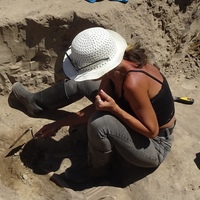
Gabriela Filip
Archaeologist
less
Related Authors
Florian Matei-Popescu
Institute of Archaeology "Vasile Parvan"
Varga Timea
Babes-Bolyai University
Sirbu Catalin Andrei
Universitatea din Craiova
Ovidiu Țentea
Romanian National History Museum
Felix Marcu
Babes-Bolyai University
Margineanu Carstoiu Monica
Romanian Academy. Institute of Archaeology - Bucharest
Ingrid Petcu-Levei
Museum for National History and Archeology from Constanta
Radu Petcu
Museum for National History and Archeology from Constanta
Nemeti Sorin
Babes-Bolyai University
Alexandra Sicoe
Universitatea "1 Decembrie 1918" Alba Iulia
InterestsView All (61)










Uploads
Papers by Gabriela Filip
framed in a tabula ansata and it is composed almost entirely of verses.
Sarcophagus of Aelius Iulius Iulianus from Romula demonstrates on one hand the taste for art of the elites, and on the other hand, their ability to express a message in an artistic manner.
weapons and their functionality, several opinions have
already been expressed in this regard. Despite this fact, the
discussions are not finished. I will describe in what follows
the discoveries of this kind from Dacia Inferior and its
surroundings. All of them are dated to the 2nd or 3rd
centuries AD.
But there is a major difference between those known from the publication and those seen in the museum, in the sense that A. Metzulescu talks about a gold ring, and at the National Military Museum I saw and photographed a silver ring (most likely, a replica), as well as the gemstone seems to be an imitation of the original (it remains to be clarified in the future).
The original gemstone had a slightly oval shape and was made of a dark green semiprecious stone, by deep engraving and polishing. On its surface were carved the figures of two characters, rendered in a face to face posture.
The one on the right of the viewer undoubtedly represents the image of a female character wearing a long dress, very draped and with sleeves. She wears a helmet on the head, and with her left arm she holds a spear (?). The right hand is stretched slightly forward, and seems to hold a small object. Her attitude is relaxed and static. The second character depicts the silhouette of a man, rendered in motion, a fact suggested by the dynamics of the long garment he wears. The right hand is easily dropped next to the body. The left arm is flexed at the elbow and raised at the level of the head, in front of the woman. In both hands he seems to be holding an object, difficult to identify.
Most likely, the subject engraved on the gemstone depicts the image of a goddess (Minerva or Libertas) rendered in the company of an emperor or priest.
No details are known about the place of discovery of the original gemstone, which can be dated, strictly based on the subject and the manner of engraving, in a generous timeframe, between the 2nd and the 3rd centuries AD.
framed in a tabula ansata and it is composed almost entirely of verses.
Sarcophagus of Aelius Iulius Iulianus from Romula demonstrates on one hand the taste for art of the elites, and on the other hand, their ability to express a message in an artistic manner.
weapons and their functionality, several opinions have
already been expressed in this regard. Despite this fact, the
discussions are not finished. I will describe in what follows
the discoveries of this kind from Dacia Inferior and its
surroundings. All of them are dated to the 2nd or 3rd
centuries AD.
But there is a major difference between those known from the publication and those seen in the museum, in the sense that A. Metzulescu talks about a gold ring, and at the National Military Museum I saw and photographed a silver ring (most likely, a replica), as well as the gemstone seems to be an imitation of the original (it remains to be clarified in the future).
The original gemstone had a slightly oval shape and was made of a dark green semiprecious stone, by deep engraving and polishing. On its surface were carved the figures of two characters, rendered in a face to face posture.
The one on the right of the viewer undoubtedly represents the image of a female character wearing a long dress, very draped and with sleeves. She wears a helmet on the head, and with her left arm she holds a spear (?). The right hand is stretched slightly forward, and seems to hold a small object. Her attitude is relaxed and static. The second character depicts the silhouette of a man, rendered in motion, a fact suggested by the dynamics of the long garment he wears. The right hand is easily dropped next to the body. The left arm is flexed at the elbow and raised at the level of the head, in front of the woman. In both hands he seems to be holding an object, difficult to identify.
Most likely, the subject engraved on the gemstone depicts the image of a goddess (Minerva or Libertas) rendered in the company of an emperor or priest.
No details are known about the place of discovery of the original gemstone, which can be dated, strictly based on the subject and the manner of engraving, in a generous timeframe, between the 2nd and the 3rd centuries AD.
https://www.youtube.com/playlist?list=PL89iPO_6ujodh2SbM7FSnVfeIkx6OmBZ3